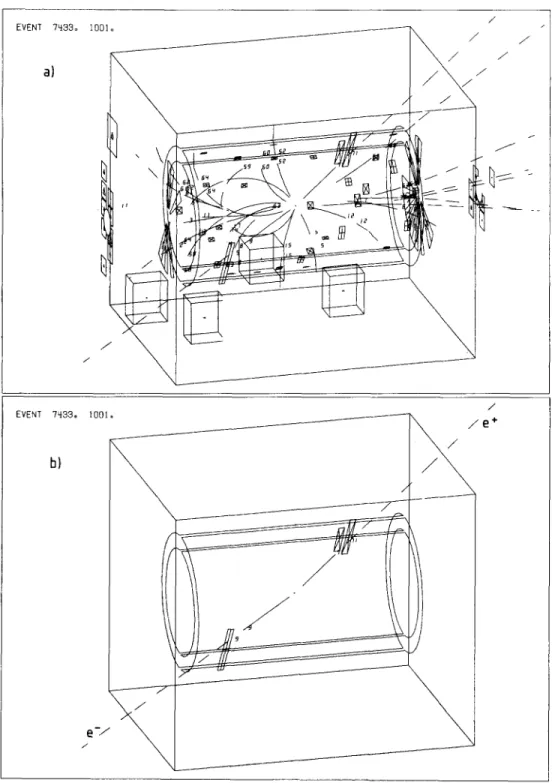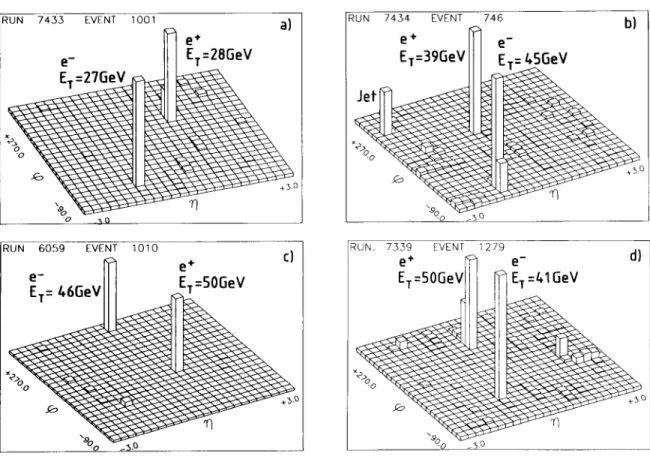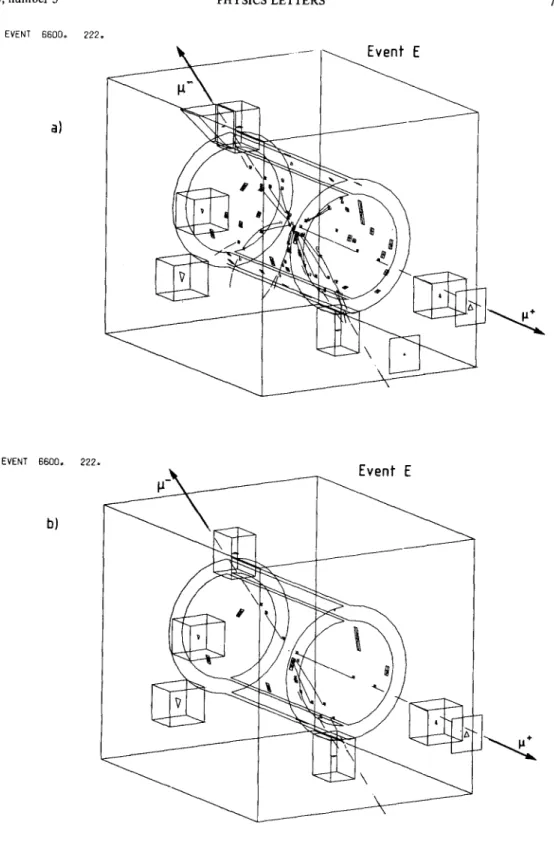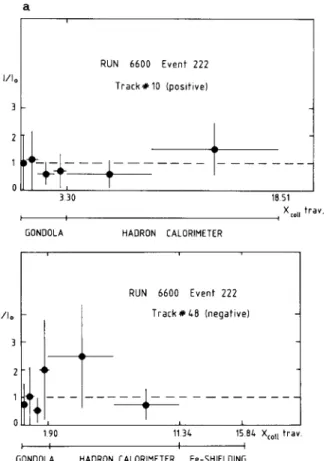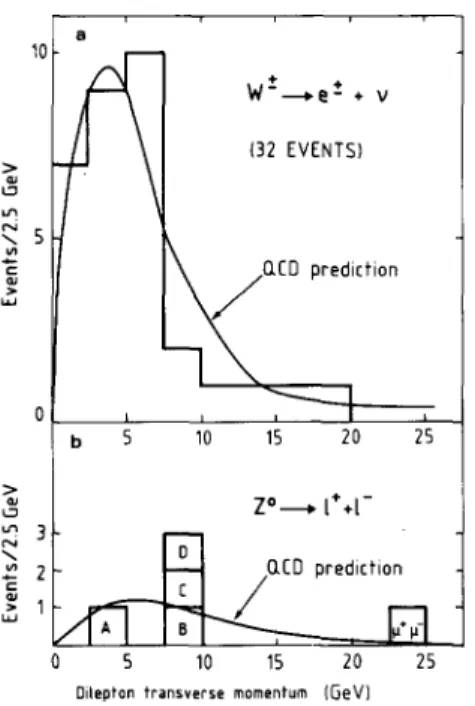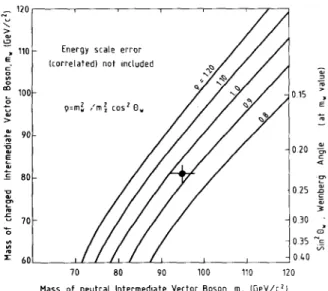Volume 126B, number 5 PHYSICS LETTERS 7 July 1983
EXPERIMENTAL OBSERVATION OF LEPTON PAIRS OF INVARIANT MASS AROUND 95 GeV/c 2 AT THE CERN SPS COLLIDER
UA1 Collaboration, CERN, Geneva, Switzerland
G. ARNISON J, A. ASTBURY J, B. AUBERT b, C. BACCI i, G. BAUER x, A. BI~ZAGUET d R. BOCK d T.J.V. BOWCOCK f, M. CALVETTI d p. CATZ b, p. CENNINI d, S. CENTRO d F. CERADINI d,i S. CITTOLIN d, D. CLINE 1, C. COCHET k, j. COLAS b, M. CORDEN c D. DALLMAN d,1, D. DAU 2, M. DeBEER k, M. DELLA NEGRA b,d, M. DEMOULIN d, D. DENEGRI k, A. Di CIACCIO i, D. DiBITONTO d, L. DOBRZYNSKI g, J.D. DOWELL c K. EGGERT a, E. EISENHANDLER f, N. ELLIS d, p. ERHARD a, H. FAISSNER a, M. FINCKE 21 G. FONTAINE g, R. FREY h, R. FR()HWIRTH l, j. GARVEY c, S. GEER g, C. GHESQUII~RE g, P. GHEZ b, K. GIBONI a, W.R. GIBSON f, Y. GIRAUD-HI~RAUD g, A. GIVERNAUD k, A. GONIDEC b, G. GRAYER J, T. HANSL-KOZAIqECKA a, W.J. HAYNES J, L.O. HERTZBERGER 3, C. HODGES h D. HOFFMANN a, H. HOFFMANN d, D.J. HOLTHUIZEN 3, R.J. HOMER c, A. HONMA f, W. JANK d, G. JORAT d, P.I.P. KALMUS f, V. KARIMAKI e, R. KEELER f, I. KENYON c, A. KERNAN h
R. KINNUNEN e, W. KOZANECKI h, D. KRYN d,g, F. LACAVA i, j._p. LAUGIER k, j..p. LEES b, H. LEHMANN a, R. LEUCHS a, A. LI~VI~QUE k,d, D. LINGLIN b, E. LOCCI k, j..j. MALOSSE k, T. MARKIEWICZ d, G. MAURIN d, T. McMAHON c, j._p. MENDIBURU g, M.-N. MINARD b
M. MOHAMMADI 1, M. MORICCA i, K. MORGAN h, H. MUIRHEAD 4, F. MULLER d, A.K. NANDI J, L. NAUMANN d, A. NORTON d, A. ORKIN-LECOURTOIS g, L. PAOLUZI i, F. PAUSS d,
G. PIANO MORTARI i, E. PIETARINEN e, M. PIMI,g, e, A. PLACCI d, j.p. PORTE d E. RADERMACHER a, j. RANSDELL h, H. REITHLER a, j._p. REVOL d, j. RICH k,
M. RIJSSENBEEK d, C. ROBERTS J, J. ROHLF d, p. ROSSI d, C. RUBBIA d, B. SADOULET d, G. SAJOT g, G. SALVI f, G. SALVINI i, j. SASS k, j. SAUDRAIX k, A. SAVOY-NAVARRO k, D. SCHINZEL d, W. SCOTT J, T.P. SHAH J, M. SPIRO k, j. STRAUSS 1, j. STREETS c, K. SUMOROK d, F. SZONCSO l, D. SMITH h, C. TAO 3, G. THOMPSON f, J. TIMMER d, E. TSCHESLOG a, j. TUOMINIEMI e, B. Van EIJK 3, j..p. VIALLE d, j. VRANAg, V. VUILLEMIN d, H.D. WAHL 1, p. WATKINS c, j. WILSON c, C. WULZ 1, G.Y. XIE d, M. YVERT b and E. ZURFLUH d
Aachen a - A n n e c y (LAPP) b -Birmingham c _ C E R N d - H e l s i n k i e Queen Mary College, London f -
Paris (Coll. de Franee) g -Riverside h - R o m e i - R u t h e r f o r d Appleton Lab. J -Saelay (CEN} k _ Vienna h Collaboration
Received 6 June 1983
We report the observation of four electron-positron pairs and one muon pair which have the signature of a two-body decay of a particle of mass ~95 GeV/c 2. These events fit well the hypothesis that they are produced by the process p + p Z ° + X (with Z ° ~ ~+ + Q-), where Z ° is the Intermediate Vector Boson postulated by the electroweak theories as the mediator of weak neutral currents.
1 University of Wisconsin, Madison, WI, USA.
2 University of Kiel, Fed. Rep. Germany.
3 NIKHEF, Amsterdam, The Netherlands.
4 Visitor from the University of Liverpool, England.
Volume 126B, number 5 PHYSICS LETTERS 7 July 1983 1. I n t r o d u c t i o n . We have r e c e n t l y r e p o r t e d the ob-
servation o f large invariant mass e l e c t r o n - n e u t r i n o pairs [ 1 ] ,1 p r o d u c e d in high-energy collisions at the C E R N Super P r o t o n S y n c h r o t r o n (SPS) [3]. T h e m o s t likely i n t e r p r e t a t i o n o f these events is that t h e y are the l e p t o n i c decays o f charged i n t e r m e d i a t e v e c t o r bosons W + and W - m e d i a t i n g o r d i n a r y w e a k interactions.
We have n o w e x t e n d e d o u r search to their neutral p a r t n e r Z 0, responsible for neutral currents. As in o u r previous w o r k , p r o d u c t i o n o f i n t e r m e d i a t e v e c t o r bosons is achieved w i t h p r o t o n - a n t i p r o t o n collisions at x / ~ = 540 G e V in the UA1 d e t e c t o r [4], e x c e p t t h a t n o w we search for e l e c t r o n and m u o n pairs rather than for e l e c t r o n - n e u t r i n o coincidences. The process is then:
~ + p ~ Z O + X
L e + e - or /a + + / a - . (1) The paper is based on an early analysis o f a sample o f collisions w i t h an integrated l u m i n o s i t y o f 55 nb - 1 . In this event sample, 27 W -+ -~ e+-v events have b e e n r e c o r d e d [5] , 2 . A c c o r d i n g to m i n i m a l S U ( 2 ) × U(1), the Z 0 mass is p r e d i c t e d to be [6] ,3 m z ° = 94 -+ 2.5 G e V / c 2. The reaction (1) is t h e n a p p r o x i m a t e l y a :fac- tor o f 10 less f r e q u e n t t h a n the c o r r e s p o n d i n g W e lep- tonic decay channels [9] , 4 . A few events o f t y p e (1) are t h e r e f o r e e x p e c t e d in o u r m u o n or e l e c t r o n sam- pies. Evidence for the existence o f the Z 0 in the range o f masses accessible to the UA1 e x p e r i m e n t can also be drawn from w e a k - e l e c t r o m a g n e t i c i n t e r f e r e n c e ex- p e r i m e n t s at the highest P E T R A energies, w h e r e deviations from point-like e x p e c t a t i o n s have been r e p o r t e d ,s
,1 See also the corresponding result by the UA2 Collaboration [2].
,2 Since the run is at present continuing at the CERN SPS CoUider, the paper is likely to contain an event sample sig- nificantly larger than what is reported here. The result for the mass of the W is m w = (81 +- 2) GeV/c 2.
,3 For latest parameters, see ref. [7]. The values used in this paper come from ref. [8]. The two-parameter fit to vg and Ota data yields o = 1.02 ± 0.026 and sin20w (mw) = 0.236
± 0.030 at the W mass. The values for the W and Z masses are then m w = (79.3._+s:sT) GeV/c 2 and m z = (89.9 ± 4.4) GeV/c 2. Imoosing 0 = 0.99 (theoretical) gives m w = (83.0+_31°) GeV/c 2 and m Z = (93.8_2~4) GeV/c. +2 s
,4 All cross sections are calculated in the leading log approxi- mation, assuming SU(2) X U(I).
,s For a summary of the results of the CELLO, JADE, MARK J and TASSO Collaborations, see ref. [10]. The result quoted is rn z = (76 -11 ) GeV/c2, or a 2 SD effect +21 from m z = .o.
This paper deals w i t h f o u r e+e - pairs and one/a+/~ - pair, c o n s i s t e n t w i t h a c o m m o n value o f invariant mass and w i t h t h e general e x p e c t a t i o n s for l e p t o n pairs f r o m Z 0 decay.
2. D e t e c t o r . The UA1 apparatus has already b e e n described [ 1 ]. We l i m i t our discussion to those c o m - p o n e n t s w h i c h are relevant t o the i d e n t i f i c a t i o n and m e a s u r e m e n t o f m u o n s and electrons.
T h e m o m e n t a o f charged tracks are d e t e r m i n e d b y d e f l e c t i o n in the central dipole m a g n e t generating a field o f 0.7 T over a v o l u m e o f 7 × 3.5 × 3.5 m 3.
Tracks are r e c o r d e d by the central d e t e c t o r ( C D ) [11], a cylindrical v o l u m e o f drift c h a m b e r s 5.8 m in l e n g t h and 2.3 m in d i a m e t e r , s u r r o u n d i n g the b e a m crossing region. A c c u r a c y for h i g h - m o m e n t u m tracks is domi- n a t e d by the l o c a l i z a t i o n error o f the electrons drifting in the gas, it is a b o u t 1 0 0 / a m close to the anode wires and 3 5 0 / ~ m after 22 c m , the longest drift path. A t this stage we find no evidence o f significant additional sys- t e m a t i c errors, even for the highest m o m e n t u m tracks * 6. I o n i z a t i o n can be m e a s u r e d to an accuracy o f a b o u t -+10% for a 1 m l o n g track. This allows identi- fication o f narrow, high-energy particle bundles (e+e - pairs), even i f t h e y c a n n o t be resolved b y the digitiz- ings.
T h e large-angle section o f e l e c t r o m a g n e t i c and h a d r o n i c c a l o r i m e t r y [ 1 ] e x t e n d s to angles o f a b o u t 5 ° w i t h respect to the b e a m pipe, and it consists o f l e a d / s c i n t i l l a t o r stacks f o l l o w e d by the i n s t r u m e n t e d iron o f the m a g n e t y o k e used as a h a d r o n c a l o r i m e t e r . A d d i t i o n a l c a l o r i m e t r y [1 ], b o t h e l e c t r o m a g n e t i c and h a d r o n i c , e x t e n d s to forward regions, d o w n to 0.2 °.
E l e c t r o n s o f the present sample have been r e c o r d e d by the central section o f the e.m. c a l o r i m e t r y , consisting o f 48 semicylindrical l e a d / s c i n t i l l a t o r m o d u l e s , w i t h an inner radius o f 1.36 m, arranged in t w o cylindrical
A large number of cosmic-ray muons traversing both the upper and the lower elements of the central detector were studied, comparing momenta determinations. Events were recorded continuously during the run and within the beam crossing gate (50 ns). Additional data were collected with beams off. This was done in order to ensure the absence of positive ion distortions in the tracks. Apart from the over- all timing, which is fitted from the track as long as there is at least one drift volume crossing, all other calibration con- stants are identical to those used for actual events. No evi- dence for systematic effects, beyond statistical contribu- tions from individual drift distance measurements, are needed to account for momentum measurements up to p
> 50 GeV/c.
399
Volume 126B, number 5 PHYSICS LETTERS 7 July 1983 half-shells, one on either side o f the beam axis. Each
module (gondola) extends over approximately 180 ° in azimuth and measures 22.5 cm in the beam direction.
Light produced in each of the four separate segmenta- tions in depth (3.3/6.6/9.9/6.6 X0) is seen by wave- length shifter plates o n each side o f the stack, which are in turn connected to four photomultipliers (PMs), two at the top and two at the bottom. Light attenua- tion is exploited in order to further improve the calo- rimeter information for localized energy depositions:
top and b o t t o m PMs give the azimuthal angle q~ with error Aq~ (rad) = 0.3/[E (GeV)] 1/2. Likewise, localiza- tion o f the coordinate x (along the beam direction) is determined, using the appropriate PMs pairings, to an accuracy Ax (cm) = 6.3/[E (GeV)] 1/2 for normal inci- dent tracks. Very inclined tracks have a substantially worse localization. Energy resolution, using all four segments and PMs, is A E / E = 0.15/[E (GeV)] 1/2. The properties of these detectors were extensively investi- gated in test beams. Energy calibrations are performed periodically with a strong, collimated 60Co source and detailed scans over the whole detector surface.
High-energy particles are identified by their behav- iour as they traverse the calorimeters. Isolated electrons are identified by their characteristic transition curve, and in particular by the lack o f penetration in the hadron calorimeter behind them. The performance of the detectors with respect to hadrons and electrons has been studied extensively in a test beam as a func- tion o f the energy, the angle of incidence, and the position of impact. The fraction of hadrons (pions) delivering an energy deposition E c below a given threshold in the hadron calorimeter is a rapidly failing function of energy, amounting to about 0.3% for p
"" 40 GeV/c and E c < 200 MeV. Under these condi- tions, 98% of electrons are detected.
Isolated muons traverse the calorimeters and the added absorbers without deviations beyond those of multiple scattering and without significant energy de- position in excess of ionization losses in the four e.m.
calorimeter and two hadron calorimeter segments. In order to detect muon tracks, 50 large drift chambers [12], nearly 4 m × 6 m in size, surround the whole detector, covering a very large area of ~ 500 m 2. Each chamber consists of two orthogonal layers o f drift tubes with two planes per projection. We have chosen a staggered arrangement for adjacent planes, thus re- solving the left-right ambiguity and at the same time
compensating for the inefficiency from the dead spaces between tubes. The extruded aluminium drift tubes have a cross section of 45 mm X 150 mm, lead- ing to a maximum drift length o f 70 mm. An average spatial resolution of 300/am has been achieved throughout the sensitive volume o f the tubes. In order to reach a good angular resolution of the muon tracks, a second set o f four planes is placed 60 cm away from the first one. This long lever arm was chosen in order to reach an angular resolution o f few milliradians, comparable to the multiple scattering angle of high- energy muons, typically 3 mrad at 40 GeV/c.
An independent momentum detern~ination of muons traversing the magnetized iron yoke is per- formed using the known position of the interaction vertex and the track coordinates after the iron. With an appropriate algorithm which reduces effects o f multiple scattering ,7, excellent agreement is found between momentum measurements in the central de- tector and the magnetized iron for vertical cosmic-ray muons in the momentum range 10--50 GeV/c. The relative precision of the momentum measurement within the iron is found to be A p / p .~ 0.20, in agree- ment with expectations, mainly due to multiple scat- tering. Cosmic-ray muons were also used to verify the relative alignments of the central and muon detectors.
The calorimeters have been made completely her- metic down to angles o f 0.2 ° with respect to the direc- tion of the beams. About 97% of the mass o f the mag- net is calorimetrized. Adding the energy depositions vectorially over the whole solid angle [ 1 ], and adding muons, under ideal conditions and with no neutrino emission, one should observe A E = 0. In practice [ 1]
transverse energy components exhibit small gaussian residuals centred on zero with rms deviations well de- scribed by the formula A E y , z = 0.4 (Y'i hE~ I) 1/2, where all units are in GeV. The longitudinal component A E x is o f little use, since it is strongly affected by energy flow escaping undetected through the beam pipes.
7 Correlations between multiple scatterings have been re- moved using the known relationship between angle and displacement: <X2ms > = (k')2<~2ms> and <X¢ms> = k<q,2ms >.
From known properties of materials, k' = 2.40, k = 1.60
(units: cm, rad). Cosmic-ray data give k' = 3.0 for the azi-
muth and 3.9 for the dip angle.
Volume 126B, number 5 PHYSICS LETTERS 7 July 1983 3. Event selection and data analysis. The present
work is based on a four-week period o f data-taking during the m o n t h s o f April and May 1983. The inte- grated luminosity after subtraction o f dead-time and other instrumental inefficiencies was 55 nb - 1 . As in our previous work [1], four types o f trigger were operated simultaneously:
(i) An "electron trigger", namely at least 10 GeV o f transverse energy deposited in two adjacent elements o f the electromagnetic calorimeters covering angles larger than 5 ° with respect to the beam pipes.
(ii) A " m u o n trigger", namely at least one penetrat- ing track detected in the muon chambers with pseudo- rapidity Ir~l ~< 1.3 and pointing in b o t h projections to the interaction vertex within a specified cone o f aper- ture + 150 mrad. This is accomplished by a dedicated set o f hardware processors filtering the patterns o f the muon tube hits.
(iii) A "jet trigger", namely at least 20 GeV o f transverse energy in a localized calorimeter cluster * a.
(iv) A global "E T trigger", with > 5 0 GeV o f total transverse energy from all calorimeters with IrTI < 1.4.
Events for the present paper were further selected by the so-called "express line", consisting o f a set o f four 168E computers [13] operated i n d e p e n d e n t l y in real time during the data-taking. A subsample o f events with E T ~> 12 GeV in the electromagnetic calo- rimeters and dimuons are selected and written on a dedicated magnetic tape. These events have been fully processed off-line and further subdivided into four main classes: (i) single, isolated electromagnetic clus- ters with E T > 15 GeV and missing energy events with Emiss > 15 GeV, in order to extract W +- ~ e -+ v events
[ 1,5] ; (ii) two or more isolated electromagnetic clus- ters w i t h e T > 25 GeV for Z 0 ~ e+e - candidates;
(iii) muon pair selection to find Z 0 ~/a+M - events;
and (iv) events with a track reconstructed in the cen- tral detector, o f transverse m o m e n t u m within one standard deviation, PT ~> 25 GeV/c, in order to evalu- ate some o f the background contributions. We will discuss these different categories in more detail.
4. Events with two isolated electron signatures. A n electron signature is defined as a localized energy
a The jet cluster is defined as in ref. [1], namely six electro- magnetic cells and two hadronic cells immediately behind.
Energy responses of calorimeters for hadrons and electrons are somewhat different.
" x
( u
= .
~u
o
~d 7=
t,O 30 20 10 0
First Level Cuts 152 Events
~ ~ ' L ~ ' l I"1 ,"1
Second Lever Cuts 6 Events
O-h
Finer Cuts Events
,
50 100
I
150 Uncorrected invariant mass duster pair CGeV/c 2) Fig. 1. Invariant mass distribution (uncorrected) of two elec- tromagnetic clusters: (a) with E T > 25 GeV; (b) as above and a track with PT > 7 GeV/c and projected length >40 cm pointing to the cluster. In addition, a small energy deposition in the hadron calorimeters immediately behind (< 0.8 GeV) ensures the electron signature. Isolation is required with ~ PT
< 3 GeV/c for all other tracks pointing to the cluster. (c) The second cluster also has an isolated track.
deposition in two contiguous cells o f the electromag- netic detectors with E T > 25 GeV, and a small (or no) energy deposition (~<800 MeV) in the h a d r o n calori- meters immediately behind them. The isolation require- m e n t is defined as the absence o f charged tracks with m o m e n t a adding up to more than 3 GeV/c o f transverse m o m e n t u m and pointing towards the electron cluster cells. The effects o f the successive cuts on the invari- ant e l e c t r o n - e l e c t r o n mass are shown in fig. 1. F o u r e+e - events survive cuts, consistent with a c o m m o n value o f (e+e - ) invariant mass. They have been care- fully studied using the interactive event display facil- ity MEGATEK. One o f these events is shown in figs.
2a and 2b. The main parameters o f the four events are listed in tables 1 and 3. As one can see from the ener- gy deposition plots (fig. 3), their dominant feature is o f two very p r o m i n e n t electromagnetic energy deposi- tions. All events appear to balance the visible total transverse energy components; namely, there is no evidence for the emission o f energetic neutrinos. Ex-
401
Volume 126B, number 5 PHYSICS L E T T E R S 7 July 1983
EVENT 7 ~ 3 3 o
a)
lOOl,
/
/
/
f
/
/
/
/
EVENT 7~33o i001. / a +
b)
/
f
/
Fig. 2. (a) Event display. All reconstructed vertex associated tracks and all calorimeter hits are displayed. (b) The same, but thresh-
olds are raised to PT > 2 G e V / c for charged tracks and E T > 2 G e V for calorimeter hits. We remark that only the electron pair
survives these mild cuts.
Table 1
Properties o f the individual electrons o f the pair events.
Drift chamber measurement Run,
event p &p a) Q dE/dx b) y c)
(GeV) (GeV) (deg)
Shower counter measurement
Eto t Electromagnetic samples ( G e V ) Had. energy
( G e V ) $I Sz $3 $4 H
33 +9 + 1.8 ~ 0.3 1.01 144
7433 -6
A
I001 63 +23 1.7 ± 0.2 -1.19 -31 -13
27 +19 + 1.6 ± 0.3 -0.36 131
7434 -8
B
746 +66
93 1.8 ± 0.2 -1.45 -60
-28
32 +ii + 1.3 ± 0.2 0.64 67
6059 -6
C I010 +i
9 1.4 ± 0.i 0.24. -121
-i
d) d) d) d) -0.19 169
7739 D 1279
50 +50 1.5 ± 0.2 -0.79 -9
-17
44 14 27 3 0.0 0.0
48 6 37 4 0.2 0.0
42 2 18 20 1.3 0.i
102 42 56 4 0.2 0.0
61 1 37 22 0.6 0.0
48 1 23 23 1.3 0.0
51 1 13 34 2.4 0.0
55 8 38 9 0.0 0.I
a) ± l a including systematic errors, c) The rapidity y is defined as positive in the direction o f outgoing ~.
b) Ionization loss normalized to minimum ionizing pion. d) Unmeasured owing to large dip angle.
RUN 7 4 3 3 EVENT 1001 a) IRUN 7 4 3 4 EVENT 746 b)
ET=39GeV ~ V
~T = t~6Gev~=SOGe V ET=50G V
Fig. 3. Electromagnetic energy depositions at angles > 5 ° with respect to the beam direction for the four electron pairs.
Volume 126B, number 5 PHYSICS LETTERS 7 July 1983
Negative tracks
GeV -1
1/E Positive tracks
-0,I -005 0 005
(1" 11p (GeVlc} "I
01 ~ p : E
0.05 / : Event A
• X
"[J
01
i i i
b
W - ~ , e . v Events
2
0 ,5
t . u
6
Z - ~ e + e - Events
-5 0 5
Xco- X6ondola (Normalized error units) Fig. 4. (a) Magnetic deflection in lip units compared to the inverse of the energy deposited in the electromagnetic calori- meters. Ideally, all electrons should lie on the 1/E = 1/p line.
(b) Normalized deviation between the track hit as computed from the central detector and calorimetry centroids. The devi- ations have been measured in test beam runs, for (i) W --- eu events and (ii) Z ° ~ e÷e - candidates. The continuous line is a unit variance gaussian.
cept for one track of event D which travels at less than 15 ° parallel to the magnetic field, all tracks are shown in fig. 4a, where the m o m e n t a measured in the central detector are compared with the energy deposition in the electromagnetic calorimeters. All tracks b u t one have consistent energy and m o m e n t u m measurements.
The low-momentum track of event C is interpreted as being due to a hard bremsstrahlung process, either
internal or in the corrugated vacuum chamber and detector walls. We have estimated the probability that one of the electrons in the sample radiates at least 70% of its energy and found it to be ~ , 9 , assuming that the "average" thickness is traversed by all the tracks. Furthermore, sensitive checks of the correct- ness of the electron assignment for the tracks can be obtained by comparing the impact of the electron tracks on the e.m. calorimeters as measured by the central detector with the centroid of the energy deposi- tion measured from the ratio of PM signals. This test is particularly sensitive along the x-direction (see fig. 4b) and it appears to be entirely consistent with expecta- tions based on the electron charge assignments of the two tracks. The average invariant mass of the pairs, combining the four consistent values, is (95.2 -+ 2.5) GeV/c 2 (table 3).
5. Events with two m u o n tracks. Events from the dimuon trigger flag have been submitted to the addi- tional requirement that there is at least one m u o n track reconstructed off line in the m u o n chambers, and with one track in the central detector of reason- able projected length (~>40 cm) and PT ) 7 GeV/c.
Only 42 events survive these selection criteria. Careful scanning of these events has led to only one clean dimuon event, with two "isolated" tracks (fig. 5).
Most of the events are due to cosmics. Parameters are given in tables 2 and 3. Energy losses in the calorime- ters traversed by the two m u o n tracks are well within expectations of ionization losses of high-energy muons (fig. 6a). The position in the coordinate and the angles at the exit of the iron absorber (fig. 6b) are in agree- m e n t with the extrapolated track from the central detector, once multiple scattering and other instrumen- tal effects have been calibrated with p > 50 GeV cos- mic-ray muons traversing the same area of the appara-
,9 The inner bremsstrahlung has been calculated according to ref. [14]. On the same subject, see ref. [15].We are grateful to F.A. Berends for his assistance with this difficult subject.
We find that the probability that either electron of the Z
--, e÷e - decay emits more than 70% of the initial particle
energy into photons is about 2.3%. External radiation has
also been calculated. It amounts to about 3.5% for the
average thickness traversed (0.1 radiation length traversed
by both electrons). However, large fluctuations can occur
as a result of critical angles due to corrugations in the
vacuum pipe, especially around 70 ° . The faulty track of
event C has an angle of emission close to this value.
Volume 126B, number 5 PHYSICS LETTERS Table 2
Properties of the muons of the dimuon event 6600-222.
7 July 1983
Track parameters Muon identification
Normalized ionization
i/io ~/CD matching d)
Q P £ y ~ lab s
e.m. Hadron Position Angle
(GeV/c) (an) (o) calorimeter calorimeter (cm) (mrad)
+ 8 a) 58.8 - 6 + 60.3 ± i0.8 b)
59.2 + 6.4 c) 170 1.19 -27.6 0.8 ± 0.5 1.2 ± 0.5 10.2 AX1 = -1.3 + 1.9 - A¢ = -2 + 6 -
- 5 . 2 ~ 2 = I i . 6 ± I 0 . 7 ~ = I I ± 1 4
+ 30 a) 65.6
-
